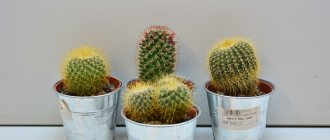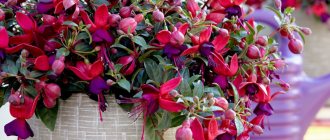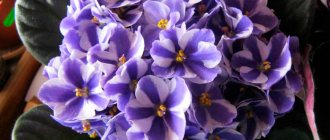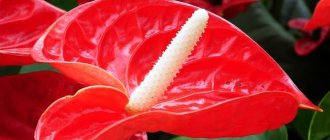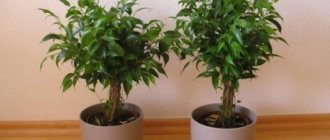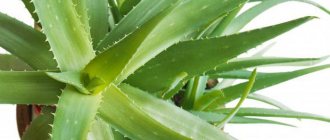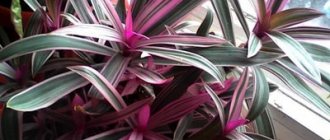Monstera is an evergreen exotic liana of the Araceae family. The epiphyte is native to the humid tropics of South America. The plant has large leaves with cuts or whole. At the top of the shoot there is a growth point.
The adventitious roots are quite long, thick and brittle. The flowers are inconspicuous, but the fruits are edible. The plant genus includes about 50 species and many varieties.
Types of monstera for the home - table
Not all types of plants are suitable for home cultivation; it depends on the region. Most often, two types are grown: oblique and lovely. You can try to keep the vines presented in the table at home:
| Kinds | Description |
| Lovely (Delicacy, Alba, Deliciosa) | Oval leathery carved leaves. The stems are thick and fleshy. |
| Variegata | Variegated leaves with light streaks. Yellow and green colors predominate. |
| Oblique | Slightly dissected oval leaves with short petioles. |
| Adanson (Irregular) | Heavily dissected ovoid thin leaf blades with small holes. |
| Thin | Rarely seen. Pinnately dissected openwork leaves. Slow growth. |
| Borziga | An unpretentious small vine. A variety of Monstera Deliciosa. |
| Doubtful (Dubia) | A small vine with entire leaves. |
Delicatessen
Oblique
Adanson
Thin
Borziga
Dubia
Variegata
Unpretentious nature allowed plants to decorate rooms of houses, offices, and botanical gardens. Thus, the variegated monstera is a symbol of luxury and wealth. It should be remembered that many vines reach large sizes and require a specific place: some species grow up to 3 meters in height.
Is Monstera dangerous or not for cats?
Although monstera is not poisonous, its juice contains substances that irritate the mucous membranes and can cause bleeding. The flower does not pose a serious danger to humans. Even if it gets on the skin, the juice will cause maximum redness and itching, which will quickly go away on its own.
But cats can be seriously poisoned by monstera. Many pets love to chew on houseplants and do not make much distinction between harmless and potentially dangerous varieties. If monstera juice gets into the animal’s mouth, esophagus and stomach, at best this will lead to severe burning and vomiting. Serious poisonings are considered rare. However, in the worst case scenario, your pet may need to seek veterinary attention due to stomach bleeding.
You can place a monstera in a growing house where animals are prohibited from going, for example, on the balcony
Caring for monstera by season - table
Liana does not require complex care. She needs a lot of water in the warm season, rest in winter and timely pruning.
At low temperatures in the house, watering should be sparse. Feeding is carried out approximately once every 30 days during growth. If the plant is always in the shade, its crown will become smaller. At very low temperatures, the leaves can turn black, and if you add abundant watering to this, they become lethargic. When the temperature is too high, the leaves curl, this occurs more often in winter.
The table shows plant care by season:
| Season | Lighting | Humidity | Temperature conditions |
| Spring Summer | Slight shadow or diffuse light. To avoid burns, it requires shading on the sunny side. In poor lighting, the leaves become smaller and cuts do not form. | Moderate. In hot weather, spraying is recommended. | From +20 to +25°C without sudden changes. No drafts. |
| Autumn winter | Artificial lighting is required. | Moderate. Regular spraying in a warm room. | Not lower than +12°C. Away from heating devices. |
It is difficult, and sometimes impossible, to achieve monstera flowering at home, since it prefers to bloom in natural conditions, but if you follow all the simple rules for caring for it, this can be achieved.
Where to put it in the apartment?
According to Feng Shui, monstera has a beneficial effect on the energy of space and helps to find peace. You can place a pot with a plant in the kitchen, hallway, living room or hallway. These rooms are best suited if you want to put your thoughts in order and achieve a state of harmony.
If you have an office at home, it will also be a suitable place for a monstera. While there, the flower will help you develop business skills and climb the career ladder. also recommended to keep the monstera in offices and near any workplace. This is an excellent plant for those who want to build a successful career and achieve financial well-being.
Perhaps the only place where you can’t put a monstera is the bedroom. It is believed that it cools marital relationships.
This is just a belief, but it’s not worth the risk when there are plenty of other suitable places to place the flower.
Planting, replanting, pruning, support
When planting a plant, you need to pay attention to the soil. It should be loose and neutral. There are several mixture options:
- take one part each of humus, peat and sand and add 2 parts of turf;
- mix one part each of bark, leaf soil, peat, moss and ½ part coarse sand;
- Add coconut fiber or perlite to the purchased soil for Saintpaulia.
Young vines should be replanted annually, as they grow very quickly. The pot should be 2-3 cm larger than the old one. It is better if its height and diameter are approximately equal. In a cramped container, the leaves may turn brown and thin, like papyrus.
The soil, drainage material and container must first be sterilized. Drainage should occupy approximately a fifth of the volume.
The plant must be replanted carefully, along with a lump of earth. Dry damaged roots must be trimmed. The vine is placed in the middle of the new container, covered with earth and lightly compacted.
Adult vines are replanted after two years. You will need fairly large flowerpots. It will depend on them how large the vine will be. The new container should be larger than the old one so that the root system feels comfortable.
Since the plant is quite large, it is better to transplant it together. Make the transplant step by step.
Replanting a very large monstera is a difficult task, so over time, only the top old layer of soil is changed with the addition of humus. If you don’t want such problems, you can start a mini plant.
A young monstera definitely needs support, as it curls. In addition, the vine will look more attractive. It is placed in a permanent place and sprayed. For an adult plant, you can make the support yourself. Sticks with coconut fiber are not a very suitable option, as it is difficult for the vine to gain a foothold. To make a support, you can take a piece of plastic tube, longer than the plant, and drill many slots in it. Next, place it in a pot and pour sand inside to the surface of the soil. Moss mixed with peat should be poured on top. The support is wrapped with damp moss, a mesh with cells on top and secured with fishing line. This design also requires regular spraying. Other options are possible.
The plant grows aerial roots, but they cannot be removed. If a vine climbs up a moss tube, the roots will grow into it themselves.
When an adult plant stops growing intensively, you can cut off its top for rejuvenation. The cut should be sprinkled with coal. This procedure promotes the growth of side shoots and crown formation.
Watering, fertilizer
Caring for vines at home is not difficult. The plant does not require frequent watering, although it is moisture-loving. Monstera leaves are covered with a waxy coating and evaporate little moisture. Watering is carried out after the soil has dried from above, preferably with warm water.
Young plants do not need fertilizing, but adults need organic and mineral fertilizers 2 times a month during the warm seasons of the year.
Flower shops have a wide selection of fertilizers. For example, “Agricola 7”, “Nitrophoska”, “Lingogumat” and others. Before use, you should read the instructions.
Useful properties of monstera
The benefits and harms of the monstera plant when caring for the crop remain balanced according to all the rules. Contrary to its name, the flower has a mainly positive effect on the home environment:
- humidifies the air and enriches it with oxygen and ozone;
- cleans the apartment of excess carbon dioxide;
- absorbs formaldehyde released by plastic and building materials;
- suppresses viruses and fungi in the apartment space;
- prevents the spread of dust;
- absorbs electromagnetic radiation emitted by household appliances;
- decorates the interior and enlivens the space.
In an apartment, dark green monstera is useful because it helps improve mood and relaxation. A houseplant strengthens the nervous system of household members and harmonizes space, stimulates thinking and imagination, and prevents aggression. When growing a tropical flower, the likelihood of developing seasonal depression is reduced. Monstera brings missing colors to the surrounding space, reminding of the sun and summer warmth.
We recommend reading: Sage oil: properties and uses for the face, gynecology and hair
It is convenient to grow the crop indoors because even one plant becomes a striking element of the decor. There is no need to place several flowers around the apartment or supplement the monstera with other perennials. A large mature plant will enliven even a very restrained space. In this case, the home design will not suffer. The culture will easily fit into a classic or modern interior and will decorate both light and dark rooms.
Advice! It is recommended to place the plant in the living room or library, office or hallway.
Monstera is often installed in offices to enliven the space.
Reproduction
Monstera propagates by seeds, cuttings and air layering:
- When propagating by seeds, light and warmth are needed. Seeds are placed in soil or damp moss. They should emerge in a month. It is recommended to leave the planting material overnight in a growth stimulator.
- When propagated by cuttings, stem or lateral shoots are planted in a pot under glass. Cuttings should be short with 1-2 leaves. A cut is made at a right angle on top, and an oblique cut on the bottom. Plantings should be watered and sprayed as the top layer of soil dries. The plant takes root and is placed in a pot.
- A layer with an aerial root and a leaf is planted in a pot.
Pests, diseases, possible problems - table
Diseases and pests rarely affect the vine, but sometimes they cause its death. The plant's leaves may curl, fall off, turn yellow, and dry out.
| Plant diseases | External signs | Fighting methods |
| Chlorosis (carried by aphids and mites) | Yellowing of leaves, appearance of light spots. | Processing with phytofarm. Feeding. Maintaining cleanliness. |
| Root rot | Yellowing and wilting of leaves. | Regulating the watering regime. Removing rotten roots and sprinkling the cuts with charcoal. |
| Spider mite | The appearance of yellow spots and spots on the leaf blades. Falling leaves. Presence of white cobwebs. | Treatment with phytoferm or derris. Regular shower with warm water. |
| Aphid | Curling, deformation and drying of young leaves. | Treatment with insecticide against aphids and preparations with permethrin. |
| Shchitovka | The appearance of hard brown plaques on the back of the leaves, drying of the tips. | Repeated treatment with a damp cloth with soapy water and insecticide. |
